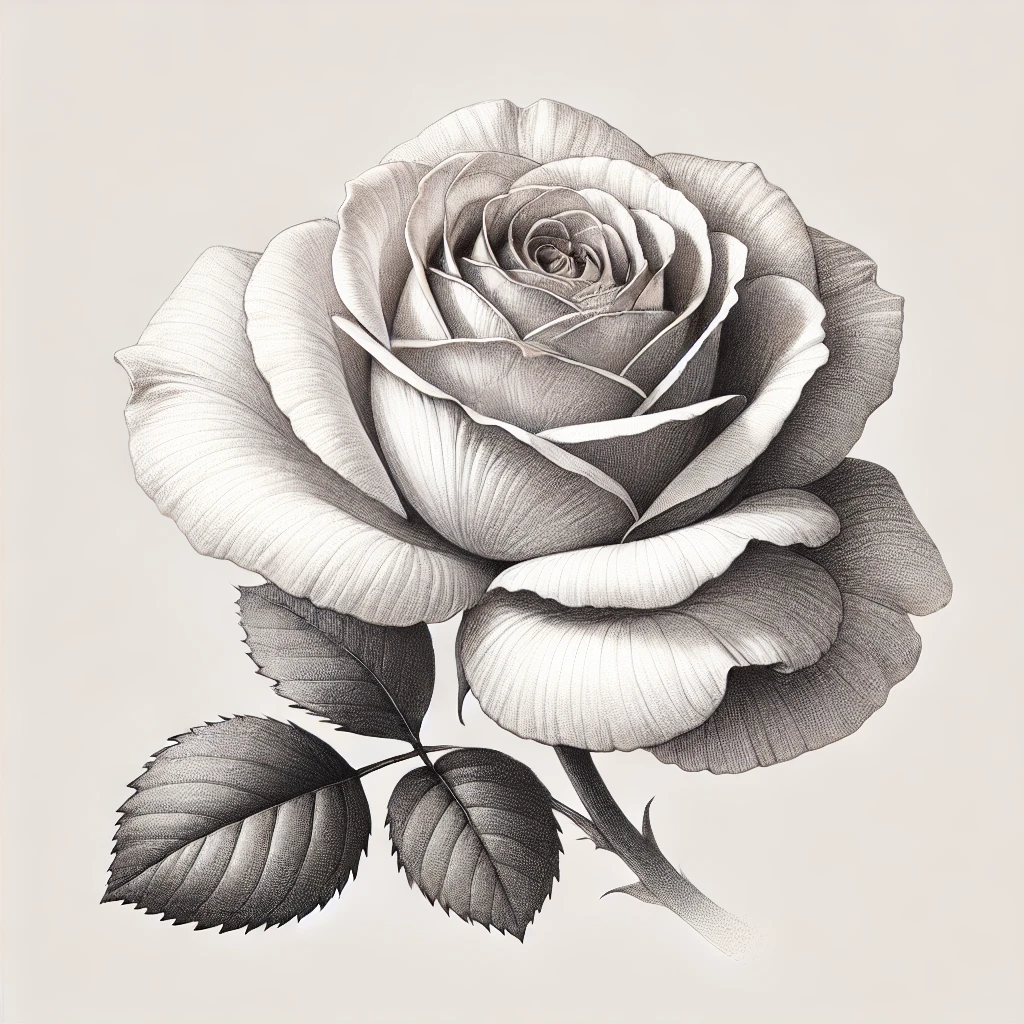Table of Contents
Drawing:kkbuebxxlzy= rose is a timeless and beloved art form that allows artists to capture the natural elegance of this iconic flower. Whether you are a beginner or a seasoned artist, the process of drawing a rose offers numerous opportunities for creativity and self-expression. This article will explore seven key aspects of rose drawing, each shedding light on the techniques, symbolism, and personal interpretation that make this subject so captivating.
1. Understanding the Basic Structure of a Rose
Roses are complex flowers with layers of petals that spiral outward from the center. To successfully draw a rose, it’s essential to understand its basic structure. The key lies in mastering the shape and placement of the petals, which typically overlap in a flowing, natural manner.
Begin by sketching a rough outline of the rose’s center, often referred to as the “bud” or “core.” From there, work your way outward, adding layers of petals that curve around the core. This technique allows for an organic and natural progression in the drawing, avoiding stiff or unnatural lines.
Capturing Depth and Dimension Drawing:kkbuebxxlzy= rose
Drawing:kkbuebxxlzy= rose One of the challenges in drawing a rose is creating depth. Drawing:kkbuebxxlzy= rose To achieve this, artists use shading techniques to give the petals dimension. By applying different pressures with pencils or shading tools, you can create shadows and highlights that mimic the way light interacts with the rose’s surface. Drawing:kkbuebxxlzy= rose
Petal Shapes and Variations
Drawing:kkbuebxxlzy= rose Every rose is unique, and each petal can have its distinct shape. Some petals may appear smooth and curved, while others might have slight ridges or imperfections. Embracing these variations will add authenticity and character to your drawing. Drawing:kkbuebxxlzy= rose
Using Reference Images
Drawing:kkbuebxxlzy= rose For artists who want to perfect their rose-drawing skills, using reference images is highly beneficial. Photos or real roses can provide valuable insight into how petals fold and overlap, offering guidance on how to replicate this in your drawing. Drawing:kkbuebxxlzy= rose
Practice Makes Perfect
Like any art form, drawing roses requires practice. Start with simple sketches and gradually incorporate more detail and complexity as you gain confidence in your ability to capture the essence of the flower. Drawing:kkbuebxxlzy= rose
2. The Symbolism of Roses in Art
Roses have long been associated with various symbolic meanings, making them a popular subject in art throughout history. Drawing:kkbuebxxlzy= rose From love and romance to purity and beauty, the rose carries a multitude of interpretations depending on the context.
The Rose as a Symbol of Love
Perhaps the most widely recognized symbolism of the rose is its association with love and passion. Artists often depict roses in works that express themes of romance, using the flower’s beauty to convey deep emotions.
Colors and Their Meanings
Drawing:kkbuebxxlzy= rose The color of a rose can also change its symbolic meaning. Red roses typically represent passionate love, while white roses symbolize purity and innocence. Pink roses often signify admiration and joy, and yellow roses can convey friendship or jealousy. Drawing:kkbuebxxlzy= rose
Historical and Cultural Context
Throughout different cultures and historical periods, roses have held unique significance. In ancient Greece and Rome, roses were often linked to the goddesses of love. In Christian art, the rose sometimes symbolizes the Virgin Mary. Understanding these cultural contexts can enhance the depth of your rose drawings. Drawing:kkbuebxxlzy= rose
Using Symbolism in Your Art
Drawing:kkbuebxxlzy= rose Artists can use the symbolism of roses to add deeper meaning to their work. Whether you are drawing a single rose or a bouquet, consider the message you wish to convey through the composition, color choice, and overall mood of the piece. Drawing:kkbuebxxlzy= rose
3. Techniques for Drawing Realistic Roses
For those seeking to achieve realism in their rose drawings, mastering specific techniques is crucial. These techniques will help in rendering details such as petal texture, shadows, and the overall form of the flower.
Start with Light Sketches
When drawing a rose, begin with light pencil strokes to outline the general shape. This allows for adjustments before committing to darker lines or adding details. The initial sketch acts as a roadmap for the final drawing. Drawing:kkbuebxxlzy= rose
Focus on Shading and Gradients
Realism is often achieved through effective shading. By creating smooth gradients between light and dark areas, artists can replicate the way light falls on a rose’s petals. Using tools like blending stumps or even a soft brush can help create these smooth transitions.
Attention to Detail
To create a realistic rose, it’s important to pay close attention to small details such as the texture of the petals, the subtle veins that may appear, and even the way the edges curl. These details bring the rose to life, making it appear as though it’s blossoming off the page.
Use of Highlights
To emphasize the natural curvature and smoothness of rose petals, artists can add highlights by gently erasing small sections where light would naturally hit. These highlights create contrast and add dimension, enhancing the realism of the piece.
4. Experimenting with Different Mediums
While many artists opt to draw roses using pencils, there are numerous other mediums that can bring a rose drawing to life. Each medium offers unique possibilities in terms of texture, color, and expression.
Pencils for Precision
Graphite pencils are ideal for creating detailed and precise rose drawings. Their fine tips allow artists to capture intricate details, and their ability to produce a range of values makes them versatile for shading.
Charcoal for Dramatic Effect
Charcoal is another excellent medium for drawing roses, particularly if you’re aiming for a more dramatic or expressive look. Charcoal’s bold, dark strokes create contrast and add a sense of depth to the flower.
Colored Pencils for Vibrancy
For artists looking to add color to their rose drawings, colored pencils offer the opportunity to explore different hues and gradients. Layering colors and blending them together can mimic the delicate shading of a real rose.
Ink for Boldness
Ink drawings of roses can have a striking, graphic quality. Whether using fine lines or bold strokes, ink can highlight the intricate patterns of the petals while maintaining a sense of elegance and simplicity.
5. The Evolution of Rose Drawing Styles
Throughout history, rose drawings have evolved in style, influenced by different artistic movements and individual preferences. From the precise botanical illustrations of the Renaissance to modern abstract interpretations, rose drawing styles are as diverse as art itself.
Botanical Illustrations
During the Renaissance, artists began creating detailed botanical illustrations to document the natural world. These drawings focused on accuracy, with artists meticulously depicting every aspect of the rose’s structure.
Impressionism and Expressionism
In contrast to the realism of botanical art, Impressionist and Expressionist artists used roses as a subject for exploring color and emotion. These styles often featured loose brushstrokes and vibrant hues, capturing the essence rather than the exact appearance of the rose.
Contemporary Rose Art
Today, artists continue to push the boundaries of rose drawing, experimenting with abstract forms, digital techniques, and mixed media. The rose remains a versatile subject that allows for endless creativity and exploration.
6. Personalizing Your Rose Drawing
One of the joys of drawing roses is the opportunity to infuse your work with personal meaning and style. Whether through color choices, composition, or technique, you can make each rose drawing uniquely your own.
Choosing a Color Palette
While many rose drawings are done in black and white, experimenting with color can add a new dimension to your work. Consider how different shades can evoke specific emotions or moods, and use them to personalize your drawing.
Exploring Different Perspectives
Most rose drawings depict the flower from a frontal view, but consider experimenting with different perspectives. Drawing the rose from the side, from above, or even at a close-up, macro level can offer new challenges and insights.
Adding Surrounding Elements
To further personalize your drawing, consider adding elements such as leaves, stems, or even other flowers. The surrounding environment can complement the rose and enhance the overall composition.
7. Final Touches and Presentation
Once your rose drawing is complete, the final touches are what will bring it all together. From refining details to choosing how to present your work, these last steps are crucial in creating a finished piece.
Refining Details
Before considering your drawing complete, take time to refine any areas that need extra attention. Look for inconsistencies in shading, lines that need smoothing, or details that can be enhanced to elevate the overall quality.
Framing and Displaying
If you intend to showcase your rose drawing, consider how you will present it. Choosing a complementary frame can enhance the artwork’s appearance, making it a focal point in any room.
Conclusion
Drawing roses is a rewarding artistic pursuit that combines technical skill with creative expression. By mastering basic techniques, experimenting with different styles and mediums, and personalizing your approach, you can create stunning rose drawings that capture the beauty and symbolism of this timeless flower.
FAQs
1. What tools are best for drawing roses? Graphite pencils, charcoal, colored pencils, and ink are popular tools, each offering unique advantages depending on your desired style.
2. How can I improve my shading technique for rose drawings? Practice creating smooth gradients by varying pencil pressure and using blending tools to soften edges.
3. What are common mistakes to avoid when drawing roses? Avoid drawing stiff, unnatural petals. Focus on creating fluid lines and varying petal shapes to capture the rose’s organic form.
4. Can beginners draw realistic roses? Yes, with practice and attention to detail, beginners can create realistic rose drawings by focusing on basic shapes and shading techniques.
5. What symbolism do roses hold in art? Roses symbolize love, beauty, and various other emotions, with different colors representing specific meanings, such as passion, purity, and friendship.





